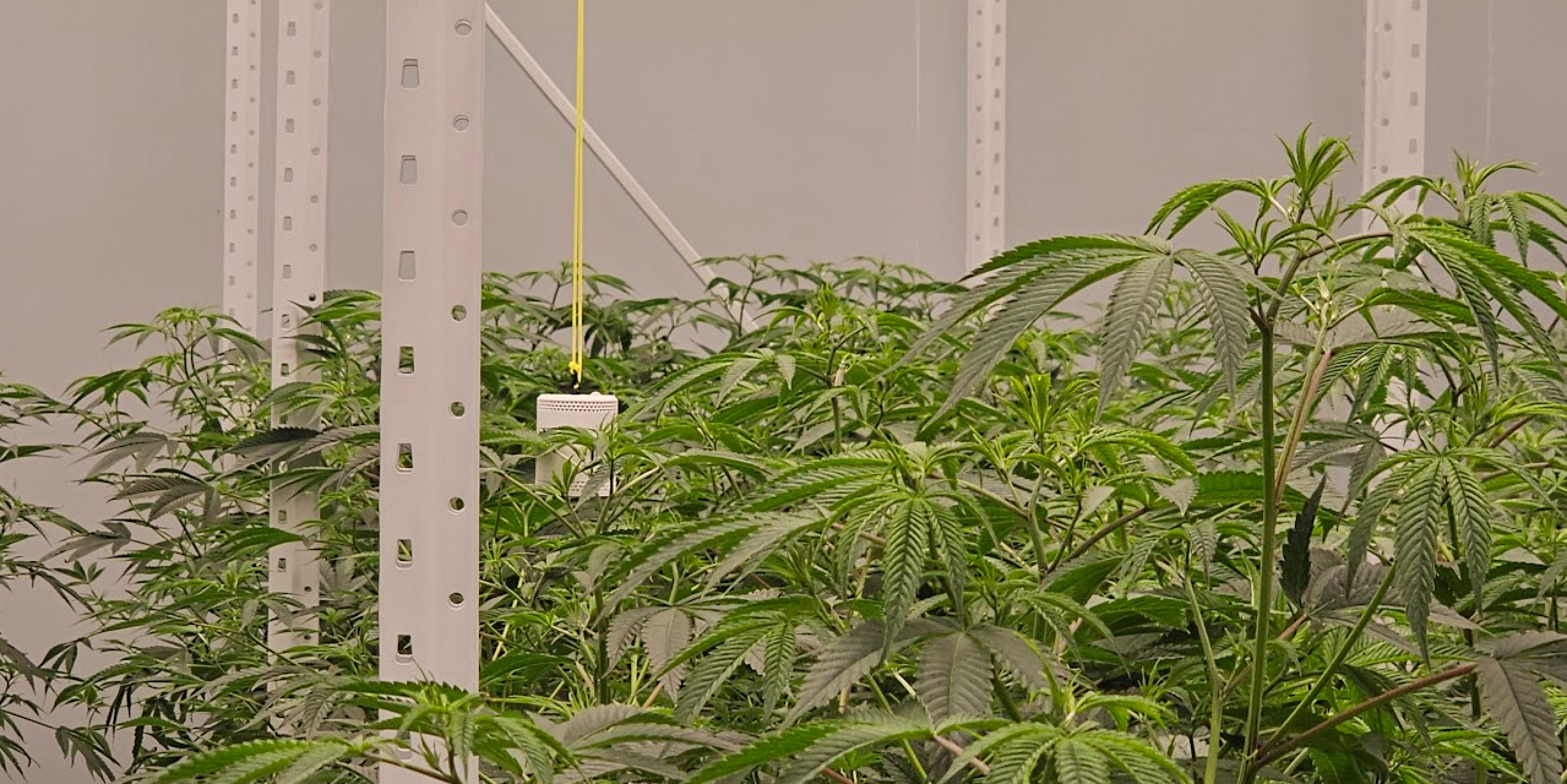Boost your cannabis yield with lollipopping techniques


Are your cannabis plants not producing the yields you hoped for?
If you want to maximise your harvest and get top-quality buds, you’ve come to the right place.
This post has the solution you're seeking: lollipopping. Without this simple technique, your plants might waste energy on lower growth that won't produce high-quality buds, leading to disappointing harvests.
We'll cover everything you need to know about lollipopping, including its benefits, the best time to do it, and how to execute it flawlessly.
With our expert advice, you'll see a significant improvement in your plants' performance and overall harvest. Let's get started!
Disclaimer: Any information given on this site is for educational purposes only. Please ensure if you’re growing cannabis, you’re doing so by the law and subject to appropriate permissions and licenses of the applicable country.
What is lollipopping?
Lollipopping is a pruning technique where you remove all the growth towards the bottom of the cannabis plant from the bottom up.
This part of the plant generally doesn’t receive enough light for the lower bud sites to form well, especially if you’re using LEDs.
By lollipopping, you focus the energy of the plant on the upper parts, resulting in better bud production.
It’s called lollipopping because, after removing the lower growth, lollipopped cannabis plants look like a lollipop.
Sign up for the Grow The Best newsletter for the best grow tips today!

Benefits of lollipopping
Lollipopping offers several benefits for your cannabis plants that can significantly enhance your harvest and bud quality.

Improved light penetration
Using this method of pruning ensures that the upper canopy receives all the light it needs, promoting the development of larger and more potent buds.
Removing the lower growth and lower bud sites eliminates shading and maximises light availability to the top buds, which is crucial for photosynthesis and overall plant health.

Enhanced airflow
This pruning technique also boosts air circulation around the plant, reducing the risk of mould, mildew, and pest infestations.
Better airflow helps maintain a healthier environment for your plants, preventing moisture build-up and promoting robust, healthy plants.

Nutrient efficiency
Removing nutrient-sapping branches lower down ensures that energy and nutrients are directed towards the top buds.
This prevents nutrient deficiencies and allows the plant to focus on producing high-notch, dense buds.
It also reduces the chances of nutrient burn or imbalance, leading to healthier plants.

Easier maintenance
With fewer branches and leaves lower down, your plants become easier to manage. This makes it simpler to inspect for pests and diseases and to maintain overall plant health.
Easier access also means more efficient watering and feeding, providing better plant care.

Increased yields and bud quality
Ultimately, lollipop pruning helps increase your overall yields by ensuring that all the plant’s resources are focused on producing the best possible buds.
If done correctly, this technique results in a higher quantity of top-shelf buds, enhancing both the quantity and calibre of your harvest.
Risks of lollipopping
While the lollipop technique can significantly enhance your cannabis yields, it’s essential to be aware of the risks involved.

Over-pruning
Removing too many branches and leaves can stress the plant, potentially leading to stunted growth and reduced bud production.
This is especially true if lollipopping is done too late in the flowering phase, as the plant may not have enough time to recover.
Improper timing
It should ideally be done during the vegetative stage and early flowering phase. If you start lollipopping too early or too late, you may negatively impact the plant’s development and overall health.
Timing is crucial to ensure the plants focus their energy efficiently on the top buds.
Risk of damage
Using the wrong tools or being too rough can cause injuries that make the plant susceptible to diseases and pests. Always use clean, sharp pruning shears to minimise damage.
Master your gardening – sign up for the Grow The Best newsletter!

When is the best time to lollipop your plants?
Timing is crucial. The right moment to lollipop cannabis plants is during the veg and early flowering stage. This ensures the plant has enough time to recover and direct its energy to the top buds.
Avoid lollipop pruning during the late flowering phase, as it can stress the plant and negatively impact the production of buds.

How to lollipop cannabis plants
It might seem daunting at first, but it’s pretty simple once you get the hang of it. Here’s how to lollipop a plant step-by-step:
- Gather your tools: You’ll need pruning shears.
- Identify the lower and weaker branches and foliage that won’t receive enough light within your grow space.
- Start removing these lower leaves and branches, working your way up to about a third of the plant.
- Be careful not to over-prune. You want to remove growth that won’t contribute to bud growth, not stress the plant.

Lollipopping indoor vs outdoor plants
Lollipopping is more common for indoor plants than outdoor plants. Indoor growers often use LEDs that aren’t as powerful as the sun, making lollipopping necessary to ensure all the buds get sufficient light.
However, you can still lollipop outdoor plants. The main difference is that outdoor plants get more direct light from different angles naturally, so you might not need to lollipop as aggressively or at all.

Lollipopping techniques and training methods
Lollipopping fits well with other training techniques like defoliation, the SCROG (Screen of Green) method and other techniques.
While lollipopping removes growth towards the bottom of the plant, defoliation involves removing some leaves to improve light exposure and air flow.
On the other hand, the SCROG technique involves training the plant to grow horizontally, ensuring even light distribution.
Combine lollipopping with these methods to help you further maximise your yields and crop calibre.
Common mistakes and tips
When lollipopping, it’s easy to make a few common mistakes. Here are some tips to avoid them:
- Don’t over-prune: Removing too much can stress the plant and reduce bud growth.
- Timing is everything: Start lollipopping during the vegetative and early flowering phases.
- Use clean tools: Dirty tools can introduce diseases to your plants.

Takeaways
The lollipopping technique is excellent for boosting your cannabis harvest and ensuring top-notch buds.
By removing the lower growth and lower buds from a cannabis plant, you focus the plant’s energy on the upper parts. Doing so improves light penetration, airflow, and overall bud production.
Give it a try and see the difference it makes in your cannabis cultivation come harvest time.
Happy growing!
FAQs
What is lollipopping cannabis?
Lollipopping cannabis involves removing the branches and foliage from the bottom of the cannabis plant that won't receive enough light.
This pruning technique ensures that energy is focused on the top buds, which leads to better buds.
Does lollipopping actually work?
Yes, lollipopping done correctly actually works. Many growers highly recommend this technique to boost the quality of their cannabis harvest.
By removing branches, leaves and parts of the plant lower down that won't receive sufficient light, you ensure that the energy of the plant is directed towards the top buds.
Does lollipopping make bigger buds?
Yes, lollipopping cannabis can make bigger buds. By removing the branches and leaves towards the bottom of the cannabis plant, lollipopping ensures that energy is concentrated on the top buds.
This focused energy leads to larger, more potent buds. It also improves light availability and airflow around the plant, which is essential for healthy bud development.
Does lollipopping increase yield?
Yes, most growers find that lollipopping cannabis can increase yield. The energy is focused on the top buds by removing low-down branches and leaves that won't receive enough light.
This results in better-developing buds and a higher overall yield. The technique also enhances light availability and airflow, which are crucial for healthy plants.
What is the difference between topping and lollipopping?
Topping and cannabis lollipopping are both pruning techniques used in cannabis cultivation, but they serve different purposes.
Topping involves cutting off the top of the main stem to promote bushier growth and create multiple top buds, which increases the number of bud sites.
On the other hand, lollipopping focuses on removing the lower branches and leaves of the cannabis plant that won't receive enough light.
This directs the energy to the top buds, improving the calibre of your crop.
While topping encourages a wider plant with more buds, lollipopping ensures that the existing buds receive maximum light and nutrients.
Should I lollipop in veg?
Yes, you should lollipop in the veg. Lollipopping during the veg allows the plant to recover and direct its energy to the top parts of the plant before flowering begins.
Removing the lower branches and leaves early ensures better light availability and airflow around the plant.
This helps the plant focus on developing more robust, healthier top buds. Starting lollipopping in the vegetative stage sets up your cannabis plant for the bets outcomes.
Remember, the best time to lollipop cannabis plants is before they enter the flowering stage for maximum benefits.
Can you defoliate too much?
Yes, you can defoliate too much. Over-defoliation can stress your cannabis plants and hinder their growth.
While defoliation helps improve light exposure and airflow, removing too many leaves can reduce the plant's ability to photosynthesise effectively.
This can lead to slower-growing plants, lower bud production, and even nutrient deficiencies. It’s important to strike a balance: remove only the leaves that block light from reaching bud sites or hinder airflow.
Overdoing it can do more harm than good, so carefully monitor your plants and adjust your defoliation technique as needed for optimal results.
What is the difference between schwazzing and lollipopping?
Schwazzing and lollipopping are both pruning techniques used in cannabis cultivation, but they differ in approach and timing.
Schwazzing involves aggressive defoliation, where most of the fan leaves are removed at specific points during the flowering stage.
This technique maximises light availability and boosts buds by exposing future bud sites to direct light.
On the other hand, lollipopping focuses on removing the lower branches and leaves of a cannabis plant during the vegetative phase.
This ensures the plant's energy is concentrated on the top buds. While schwazzing is a high-risk, high-reward technique, lollipopping is generally less stressful for the plant and focuses on enhancing yield.
Unlock premium growing secrets – join the Grow The Best newsletter!









.avif)








